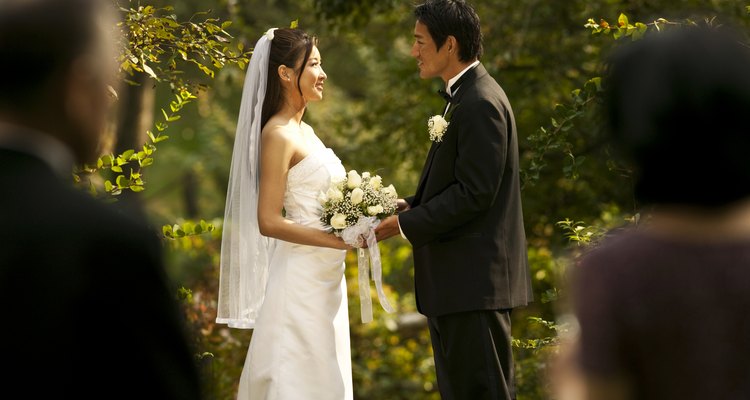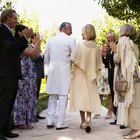
A non-religious wedding ceremony, also known as a civil ceremony, is one performed when a couple does not wish to have a full religious ceremony. A civil ceremony can still have some religious aspects in the couple’s vows, special readings or symbols used in the ceremony. Non-religious ceremonies can be performed in a judge’s chambers or by another officiant authorized to perform wedding ceremonies in your state.
Introduction
During the opening of the ceremony the officiant introduces the bride and groom to the guests and thanks everyone for being there. Depending upon what was discussed during the planning of the wedding, the officiant may talk about how the couple met or the blending of two families. During this time, he may also introduce parents, grandparents or other special relatives present at the ceremony.
Readings
If the couple desires, a poem or something written for the couple can be read by a close friend or family member. Though this is a civil ceremony the couple can also choose to have a religious excerpt read to add some religious meaning to the ceremony. Readings can be done either before or after the vows have been exchanged.
Vows and Rings
If desired, couples can write their own vows to be read to each other during a civil ceremony. If vows have not been written the officiant will read from a pre-formatted non-religious set of vows. The rings are not blessed or given religious meaning as they are in a religious ceremony. The couple exchange rings and speak their vows.
Final Words
After the ring exchange the couple then kisses for the first time after being married. Then the officiant announces the new couple, recognizing them for the first time as Mr. and Mrs. Smith. The couple then leaves down the aisle or walkway and is followed by the rest of the bridal party.
Related Articles

Christian Wedding Prayers and Blessings

How to Officiate a Wedding Renewal

How to Cook Shrimp in a Skillet

What Is the Benediction in a Wedding ...

Minister Checklist For a Wedding

Mandatory Legal Phrases for Wedding Vows

How to Emcee at a Rehearsal Dinner

Mother of the Bride Wedding Speech Ideas

Can a Notary Republic Marry People?

Traditional Wedding Prayers and ...

How Long to Cook Steak at 150 Degrees ...

What Is the Difference Between a ...

How to Write a Commitment Ceremony

How to Write a Welcome to the Family ...

Who Can Legally Perform Marriages in ...

How to Reheat Leftover Pork Chops ...

Wedding Ceremony Sequence of Events

How to Sign a Marriage Certificate ...

How to Announce a Newly Married Couple

How to Stop Female Facial Hair
References
Writer Bio
Heather Leigh Landon has been a writer since 1988 when she started her career as a stringer for "The McHenry Star News." Since then she has worked for newspapers such as "The Woodstock Independent," "The Northwest Herald" and "Press Journal." Landon graduated from William Rainey Harper College with an Associate of Applied Science in journalism.
Photo Credits
Comstock Images/Comstock/Getty Images